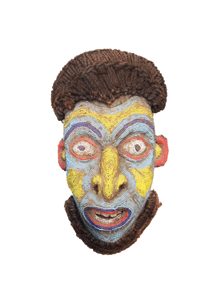
"THE ROYAL BEADED MASK" Bamum Kingdom;
Beads, wood, fiber, and cloth. |
When Cameroon is in the news, it’s usually in relation to its authoritarian president Paul Biya, a corrupt and sometimes brutal dictator who enjoys sweeping unilateral power and has kept office since 1982. So it might be refreshing to be afforded a step away from the region’s present politics and toward its cultural history. Through late winter, Portlanders can do so with “The Spirits of the Grassland,” an evocative, transportive exhibit of icons, artifacts, and spirit masks from some of the many, many cultures and “kingdoms” of West Africa, what is now Cameroon and Nigeria.
Labeled “Bushmeat,” one of the show’s early works is an exercise on the minimal possibilities of the mask form. It’s mounted on the wall as a stirring assemblage of wood and nails sculpted into a vaguely skull-like figuration — nothing painted or adorned. Lifelike and lurid as the other pieces are, “Bushmeat” is a particularly poetic allusion toward the raw, mathematical violence of the grasslands, its bareness of form lending it a corporeality and narrative capacity that the other masks forgo in their pursuit of the spirit world.
Elsewhere, a 19th-century Cameroonian royal mask fuses the symbols of the elephant and the panther, two totems of authoritarian power found in Northwest African cultures. An Obu-Iru n’abo spirit mask, sourced to Abakaliki, Nigeria in 1945, summons a commoner theme, depicting a figure with two faces beneath a large carrying pot, shedding light on the social reality of the grasslanders by illustrating their most existential question: whether to keep going with the pot on their shoulders — the significance of which falls anywhere between social responsibility or cultural burden — or to put it down and liberate themselves from it. “What is in the pot that you are carrying? How heavy is it?” asks an exhibit tag. The Obu-Iru n’abo mask is typical of the social complexities wrought out by the entire exhibit, colliding the divergent, often irreconcilable lives and beliefs of royalty and citizen, flesh and spirit.
And those collisions can look pretty gruesome. The Obuee-Otaa, a sculpted figure of a spirit god from the Ebii Village in Nigeria (dated 1800), is a massive statue said to depict the complexities of good and evil. Its giant facial features and bloodshot eyes are haunting and prominent; its entire upper half cloaked in a mane of straw. The museum has mounted it on a large pedestal, narrowing its lower half to dimensions at odds with its bulbous frame, recreating a sensation consistent with the history of the Obuee-Otaa, which Ebii Villagers would perform to change shape and size during ceremonies and rituals of its era. The staid environment of art museums can render any spirit benign, but this figuration (which women and children were allegedly disallowed from viewing during performances) still seems
spiritually pregnant and vividly powerful.
Whether you see art works or cultural artifacts, there’s a profound historical majesty in this collection, one Western audiences rarely have the pleasure of seeing up close. (Modern Western life contains no objects quite like the gigantic clay medicine pot collected here, as large as the circumference of adult arms and teeming with protuberances to aid gripping.) Yet it’s in the subtle instances of structural power seen behind the masks and objects where the show finds its deepest purchase, the reverent edifications of royalty teetering next to timeless, transcendent incarnations of evil.